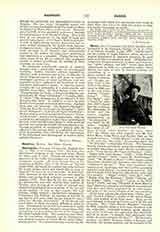

Harris, JOEL CHANDLER, folklorist, novelist, poet, journalist; b. at Eatonton, Georgia, U.S.A., 1848; d. at Atlanta, Georgia, July 3, 1908. Chiefly known for his stories of negro folk-lore which created an original department in American literature, he spent most of his life in journalistic work. Of humble parentage and meagre education, he knew and loved as a boy “fields, animals, and folk” better than books. Apprenticed in 1862 to a plantation editor, whose library was open to him, he learned printing and journalism in a grove, worked on various Louisiana and Georgia papers, and from 1876 to his retirement in 1890 was on the staff of the Atlanta “Constitution”. “The Tar Baby”, contributed by accident (1877), found him his vocation. His knowledge of nature and the negro, acquired unconsciously in “the plantation”, ripened as he wrote, resulting in a series of volumes whereof “Bre’r Rabbit” the hero, “Bre’r Fox” the villain, and other animals, with Mr. Sun, Sister Moon, Uncle Wind, and Brother Dust are the dramatis personae. “Uncle Remus”, a wise old negro, is the narrator, “Miss Sally” the guardian spirit, and “the little boy” a breathless listener. Wit, humor, homely wisdom, and kindly sympathy, combined with unrivalled knowledge of negro dialect and character, make “Uncle Remus, His Songs and Sayings” (1881), “Nights with Uncle Remus” (1883), “Uncle Remus and His Friends” (1893), “Little Mr. Thimblefinger” (1894), “Mr. Rabbit at Home” (1895) unique among folk-stories, distinctively American, and interesting to “children of all ages”. They were translated into twenty-seven languages, and their author, popularly named “Uncle Remus”, was lost in the narrator. But apart from his Uncle Remus’s tales Harris ranks high as a novelist. “Mingo” (1884), “Free Joe” (1887), “Daddy Jake the Runaway” (1889), “Balaam and his Master” (1891), “Aaron“, “Aaron in the Wild-woods” (1893), and the “Chronicle of Aunt Minervy Ann” disclose a sympathy and intimate acquaintance with slave and master possessed by no other writer, and point to the wisest solution of the race problem.
Of his forty volumes he prized most “Sister Jane” and “Gabriel Tolliver”, stories of his native Shady Dale, and written in his later years. They are his most finished work and the best record of his life and thoughts. The “Uncle Remus Magazine”, founded in 1906, contains many a wise essay flavored with the originality, whimsical humor, gentle charity, and purity of thought and expression that characterized all he wrote: “a homely, kind philosophy that uplifts the mind and grips the heart”. His favorite reading—the Bible, Newman, Faber, a Kempis, and Sheehan—his mental honesty, and the example of his wife, a cultured Canadian Catholic (the Mary Bullard of “Gabriel Tolliver”), to whom he credited his mental growth and the best that was in him, had long convinced him of Catholic truth. But a sensitive modesty that shunned notoriety and crowds, and confined him to the society of his family, restrained him from seeking baptism till June 20, 1908, a few weeks before his death. He died with the sole regret that he had so long deferred his entrance into the Catholic Church. The universal tribute paid him showed that he had grown into the heart not only of the South, but of the nation. Atlanta has purchased his residence, “The Wren’s Nest”, and his “Snap-bean Farm” to transform them into “Uncle Remus Park” as a monument to his memory.
MICHAEL KENNY

